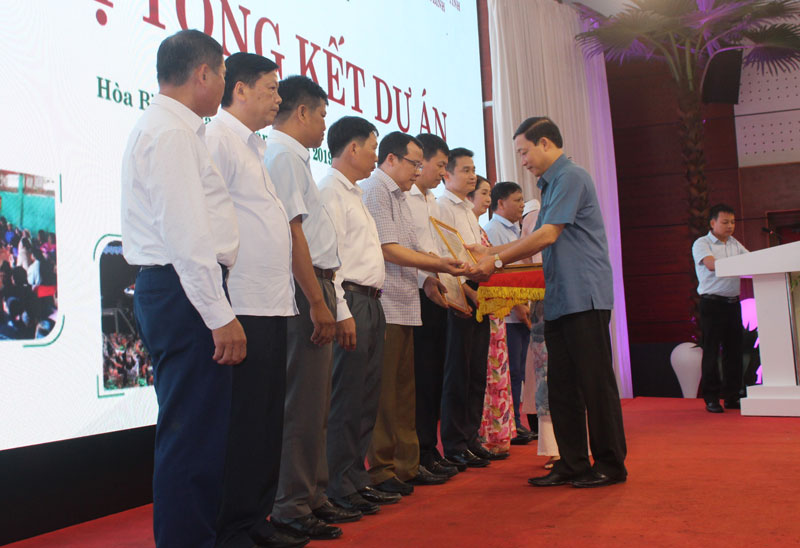
(HBO) – The Hoa Binh provincial People’s Committee on August 27 held a conference to wrap up the second phase of a project on poverty reduction.
After the success of the first phase in the 2002-2007
period, as Hoa Binh remained one of the most disadvantaged provinces in Vietnam’s
northern mountainous region, the province was chosen to be among six provinces to
join the project’s second phase by the ministries, sectors and the World Bank
(WB).
In the nine years from 2009 to 2018, with a budget of more
than 849 billion VND (36.56 million USD), of which over 770 billion VND was
mobilised from loans provided by the WB, the project was implemented in 374
villages of 42 communes in five communes of Da Bac, Mai Chau, Tan Lac, Lac Son
and Yen Thuy.
More than 154,400 local households benefitted from the
project while over 6,000 activities in small-scaled infrastructure and
livelihoods were invested in, with the communal-level authorities as managers, and
more than 250 in infrastructure and connectivity, with district-level ones.
 Vice Chairman of the provincial People’s Committee Bui Van
Cuu presents certificates of merit from local authorities to collectives with
outstanding results in poverty reduction activities.
Vice Chairman of the provincial People’s Committee Bui Van
Cuu presents certificates of merit from local authorities to collectives with
outstanding results in poverty reduction activities.
As of June 2018, as many as 209 construction works with
district-level authorities as investment managers had been completed,
benefitting more than 27,100 households. Meanwhile, over 1,000 infrastructure
sub-projects with communak-level authorities as investment managers, have
helped about 70,700 families.
In addition, 37 partnerships were established in the period,
drawing the participation of 14 partners and more than 8,700 households and
organizations, with 397 groups sharing the same interest.
Addressing the event, Vice Chairman Cuu spoke highly of the
results of the project’s second phase for the province’s socio-economic
development.
He said that even though the second phase has come to an end,
it is important for sectors, districts and communes to further improve capacity
of staff to bolster resources.
The localities receiving infrastructure investment need to care
for, protect and zone off budget to preserve and bring into full play the
efficiency of the construction works, in order to avoid the phenomenon that
when a project ends, its infrastructure is neglected and becomes dilapidated./.
The Department of Education and Training of Hoa Binh province held a conference on March 18 to review the performance of the "Safe and Happy School" Project and set out tasks for 2025. The project, funded by the Taiwan Fund for Children and Families (TFCF), aims to create a safe, inclusive, and supportive learning environment for students. The event saw the attendance of representatives from the TFCF and 26 beneficiary schools.
With over 70% of their workers being women, trade unions across industrial parks (IPs) in Hoa Binh have been actively safeguarding their legal rights and interests while implementing initiatives to improve their income and well-being.
In recent years, the Hoa Binh provincial General Hospital has continuously innovated itself and improved the quality of medical services to meet the increasing needs of local people. With substantial investments in infrastructure and modern equipment, along with a team of highly qualified doctors and nurses, the hospital has gradually established itself as one of the leading medical units in the Northwestern region and a trusted destination for healthcare for people inside and outside the province.
From mastering the fundamentals of programming to achieving national recognition, the Programming Club of the Le Van Tam Primary School (STAR LVT28) in Hoa Binh city has made remarkable strides in the field of robotics.
The Ho Chi Minh Communist Youth Union Committee and the Vietnam Youth Federation chapter of Hoa Binh province organised a programme on March 12 to launch the "Digital Literacy" movement and an online quiz on the resolutions of the Vietnam Youth Federation congresses at all levels, as well as the Politburo's Resolution No. 57-NQ/TW on breakthroughs in the development of science, technology, innovation, and national digital transformation.
As climate change grows more unpredictable, the development of production forests has become essential - not just for economic growth, but for safeguarding the environment and maintaining ecosystem balance. By boosting local incomes, curbing natural disasters, preventing soil erosion, and protecting water resources, these forests play a crucial role in sustainable development.



 Vice Chairman of the provincial People’s Committee Bui Van
Cuu presents certificates of merit from local authorities to collectives with
outstanding results in poverty reduction activities.
Vice Chairman of the provincial People’s Committee Bui Van
Cuu presents certificates of merit from local authorities to collectives with
outstanding results in poverty reduction activities.